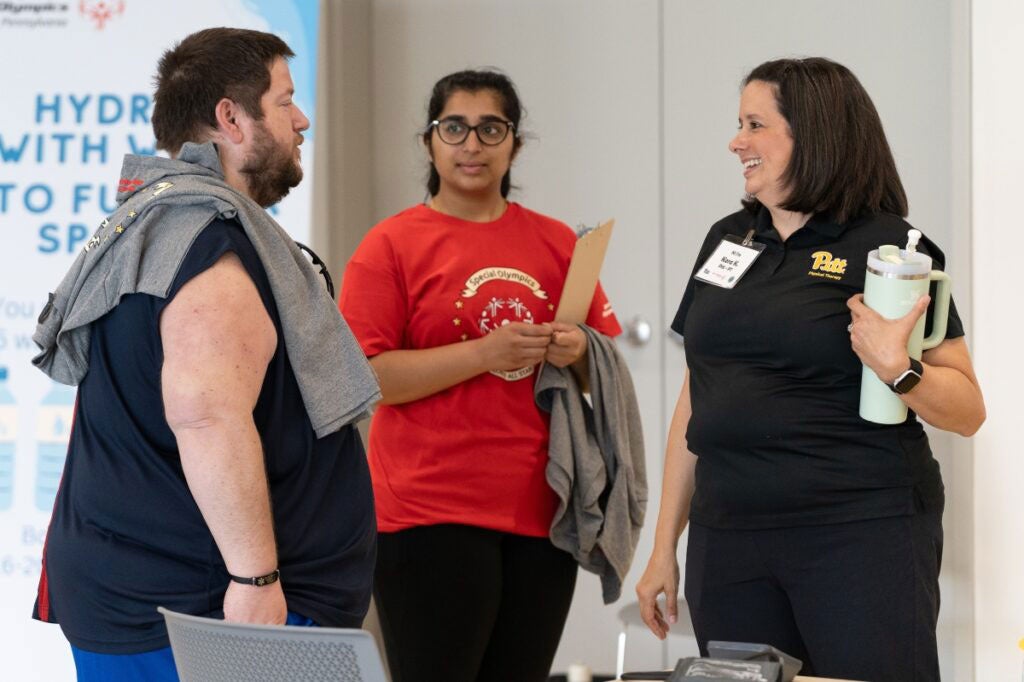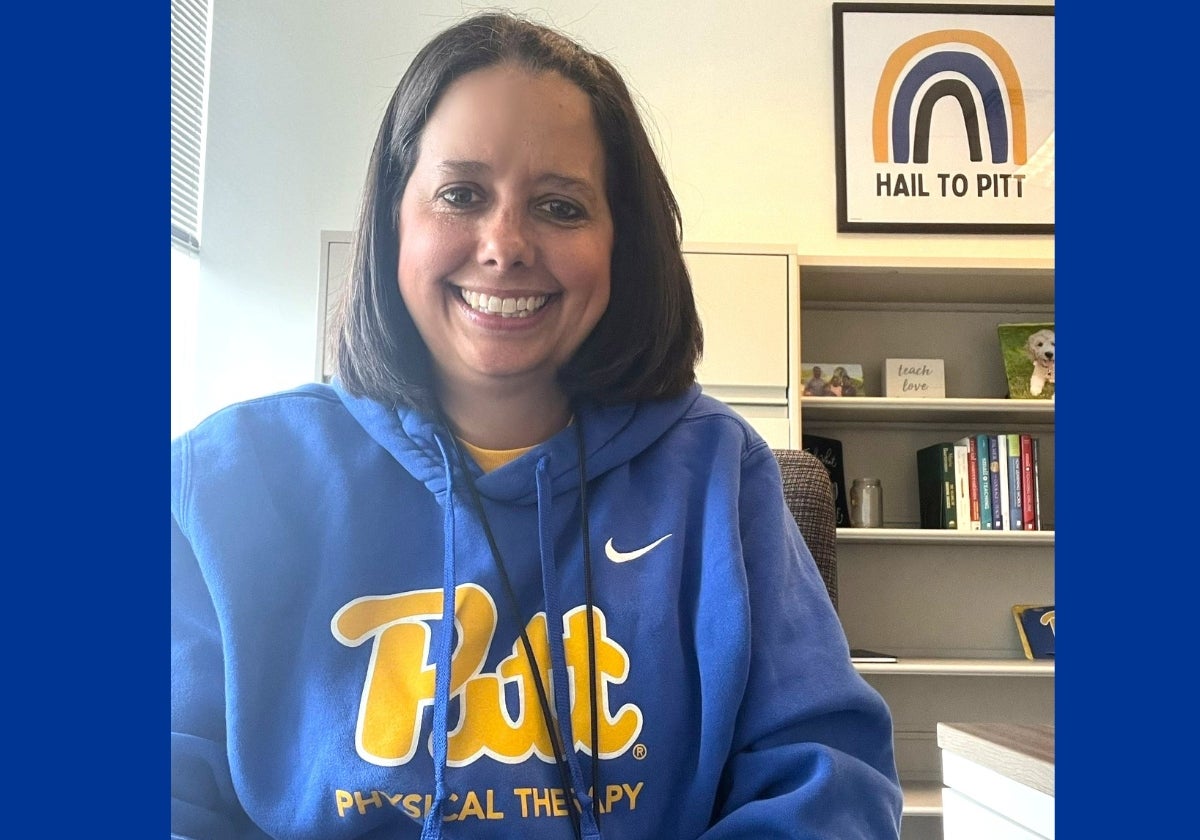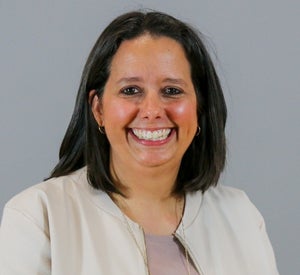It’s hard to meet a more enthusiastic or passionate educator as Kara Kobal, Pitt Department of Physical Therapy associate professor and director of the Doctor of Physical Therapy (DPT) on-campus option, a position she’s held since 2021. Kobal teaches not only the DPT on-campus students, but also those in the hybrid learning environment, which gives her exceptional insight on ensuring the success of all Pitt physical therapy (PT) students.
Discovering Physical Therapy
I was lucky that I decided on PT as a career when I was still in high school. As is common with many in this profession, I was first introduced to the profession while participating in physical therapy as a patient. I’ve always loved being around children and was initially drawn to special education because of that, but everything changed when I learned that physical therapists could work with children in a variety of settings. Pediatric physical therapy was a perfect mix of my two callings—education and physical therapy. Eventually, my passions brought me full circle and back to Pitt PT as an educator! I’m truly blessed to be able to combine all my passions into a job that I love.
The Pitt DPT On-Campus Option
What do you enjoy about leading this program option and teaching physical therapy students?
Being a physical therapy educator, I have the unique opportunity to play a role in the future of our profession. I love the feeling of looking out into a group of students and knowing the future leaders of the PT profession are out there. What an honor it is to have a role in shaping these amazing clinicians of the future! Education is not only a passion of mine, but also a responsibility that I take very seriously. This position allows me to work with many different members of faculty as well as students in both the hybrid and residential options. I believe that our program is strengthened by the diversity of faculty, staff and students. I have enjoyed contributing to our program’s efforts to recruit and support a more diverse population of educators and learners.

A Unique Perspective on Both DPT Learning Options
You are the DPT on-campus option director while also teaching the DPT hybrid option. How has this impacted your approach to teaching?
While I have spent most of my career teaching in a traditional in-person learning format, I benefitted from high quality hybrid teaching and learning as I pursued my Doctor of Health Science Degree in Rehabilitation Science at Drexel University. The hybrid program that I attended afforded me the opportunity to pursue a higher degree while living in a rural area of Pennsylvania and raising young children. Experiencing hybrid teaching and learning from the student perspective was eye-opening and it’s what really fueled my desire to pursue work in this educational model. It allowed me to think differently about the unique needs of different learners as well as the barriers to access.
My position in both formats has allowed me to bridge gaps to strengthen the program in meaningful ways. I’ve been able to help identify what works well in each setting and apply that to enhance the overall instructional design and delivery in both environments. As I bring the best practices from teaching and learning in both traditional and hybrid learning formats together, the end result is improved classroom experiences for students in both options. Without having a role in both options, I would not have the same perspectives.
Has your position in both options afforded you the opportunity to strengthen the DPT program as a whole, in ways otherwise not possible without you being there?
With growth comes challenge and our program has certainly risen to the challenge of redefining what physical therapy education can look like. Our goal in growing our program is to open up possibilities for all students and to be the leader in transforming what physical therapy education may look like in the future. When we open ourselves to this growth, it also opens the door for faculty in both options to collaborate in supporting an exemplary curriculum with multiple modes of delivery. We have been able to adapt active learning strategies commonly used in traditional settings into our hybrid model and conversely, we have also been able to incorporate technology and asynchronous tools typically used in hybrid options into our traditional format. We are certainly a stronger program because of this collaboration.
What are areas where the two options need to be different in order to best support the learners and faculty of that option?
We work hard to ensure that the curriculum for each course aligns between the in-person and hybrid learning formats. While course objectives and syllabi align, we also understand that best practices in teaching and learning can look different between in-person and hybrid learning options. Additionally, the courses have different structures as the traditional option offers classroom and lab learning mixes throughout the term and the hybrid option alternates classroom learning and immersions in blocks of time throughout the term.
Leading Hybrid Education
In your experience, what remains an opportunity for improvement within hybrid DPT programs overall and how is Pitt PT poised to tackle that challenge?
Hybrid-based programs remain a relatively new educational structure for physical therapy education. Therefore, many opportunities for growth exist. There is a definite need for more research to inform best practices in hybrid teaching and learning that is specific to health sciences. As a Pitt alumna (DPT ‘05), one of the things that has stuck with me and continues to fuel my Pitt pride, is the commitment of the University and program to be innovative. The University of Pittsburgh Department of Physical Therapy looks forward to being the leaders in this type of educational research that will inform best practices hybrid teaching and learning around the world.

Applying Critical Reasoning to the Curriculum
You have tremendous experience and interest in clinical decision-making and clinical reasoning and have received funding for this research. Can you expand on these experiences?
My research centers on developing and evaluating strategies that enhance clinical reasoning in entry-level physical therapy education. Clinical reasoning is essential for effective, patient-centered care, yet it’s often underrepresented as a formal competency in PT curricula. My work aims to bridge that gap by exploring evidence-based instructional methods that can support students in thinking critically and applying knowledge in real-world clinical scenarios.
Why is this so important for students to learn and how is Pitt PT positioned to lead this topic in its curriculum?
Clinical reasoning is really the basis for how physical therapists make decisions in the clinical environment. Clinical reasoning requires complex thinking and integration of multiple concepts in order to generate clinical-based decisions. Being deliberate about teaching this reasoning process to students will lead to better patient outcomes as well as more confident clinicians. Clinical reasoning is a course thread in the Pitt DPT program, meaning it is taught in many different courses along the continuum of learning. We have more than one DPT faculty member who has published research in this area, and we continue to grow our curriculum support for this thread.

Fun Facts
What fun facts would you like students to know about you?
- I live in Johnstown, PA, with my husband and three kids. My “after work” calendar is powered by my kids’ activities and cheering from the sideline or audience. Being my kids’ biggest fan is the best job I’ve ever had (a close second is cheering on my students and patients).
- Volunteering at Special Olympics and going to the beach are two of my favorite happy places.
- I am a die-hard Pitt Panthers fan. One of my family’s favorite activities is attending Pitt football games and other sporting events.
- I have traveled to many different cities, and Pittsburgh is still my favorite.
- I’m a big dog lover—if you have one, I probably already want to meet it.

